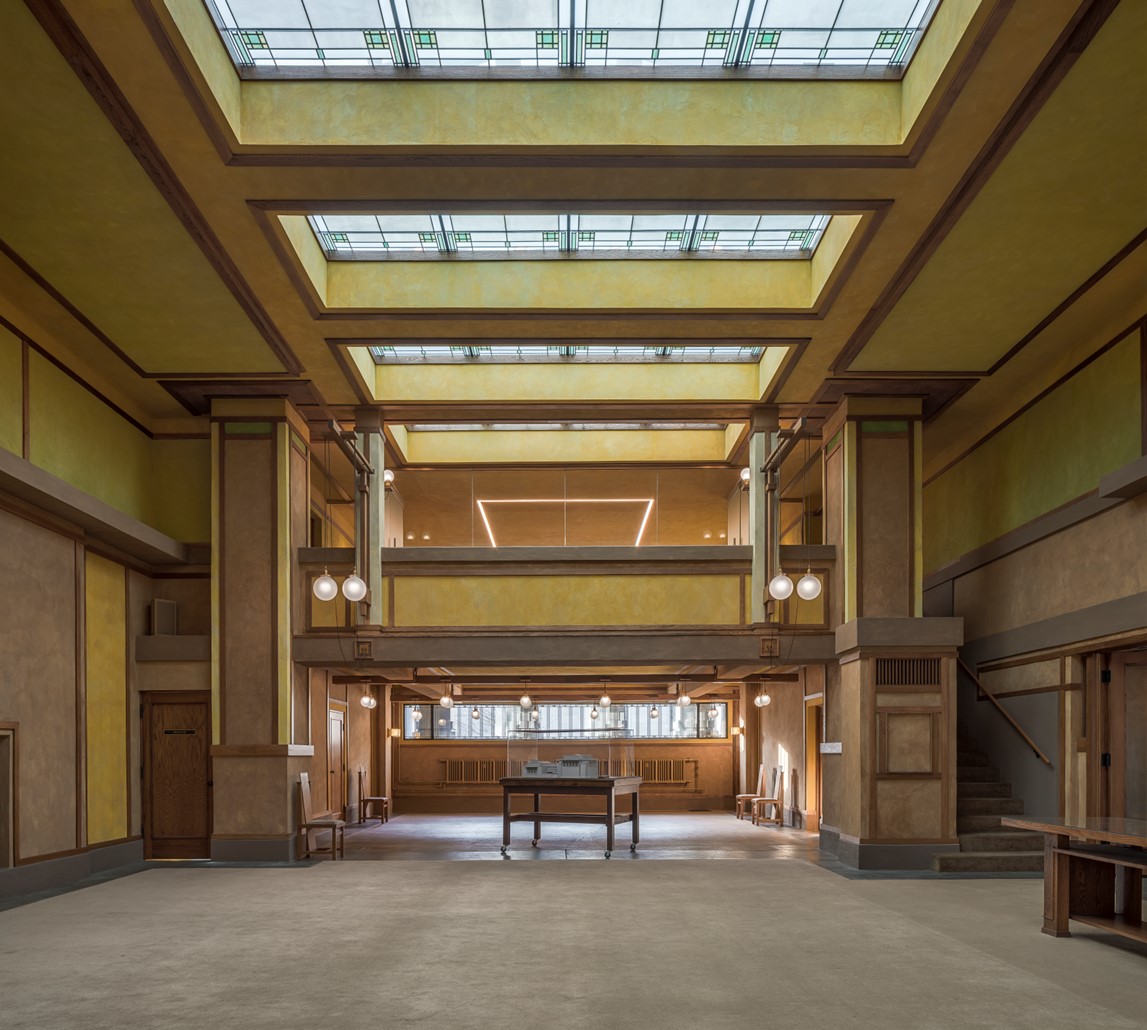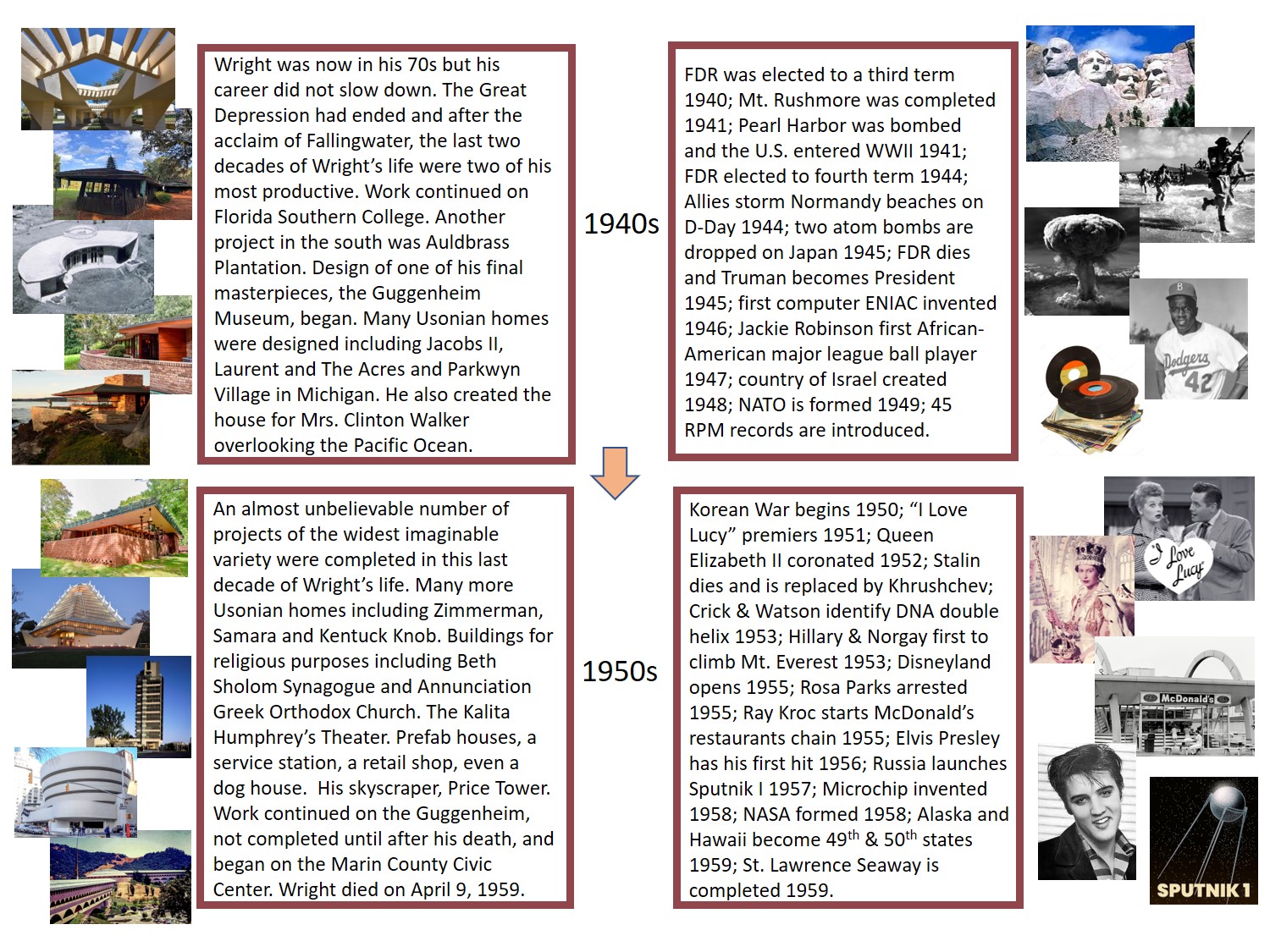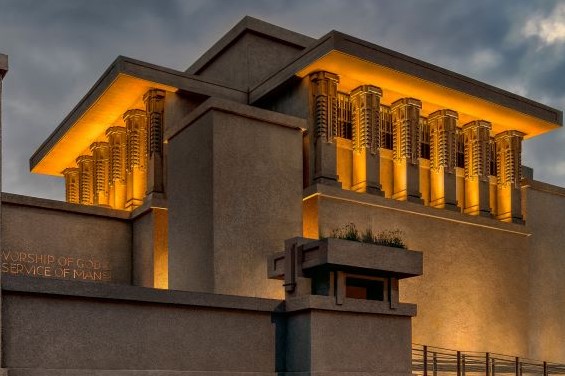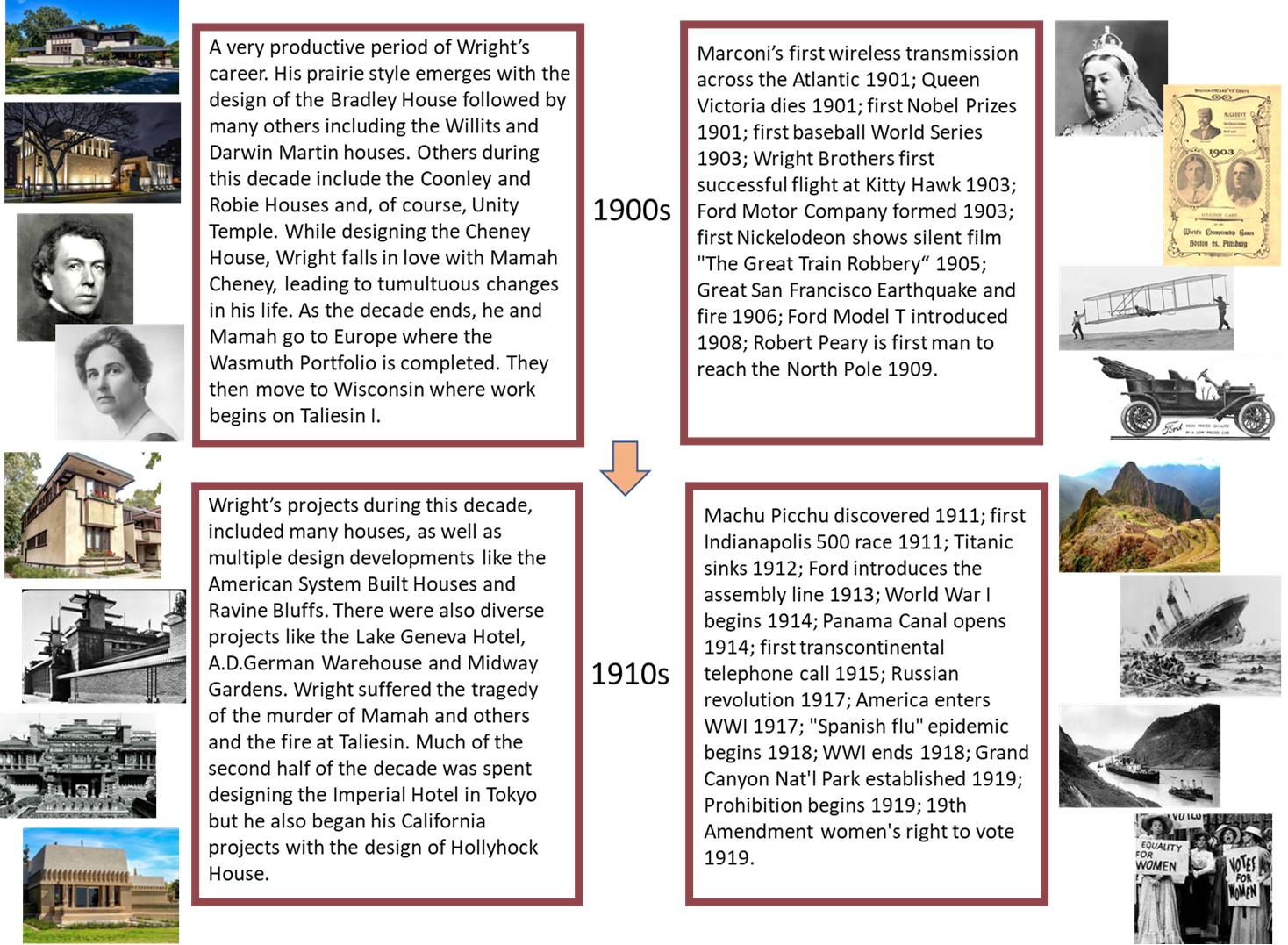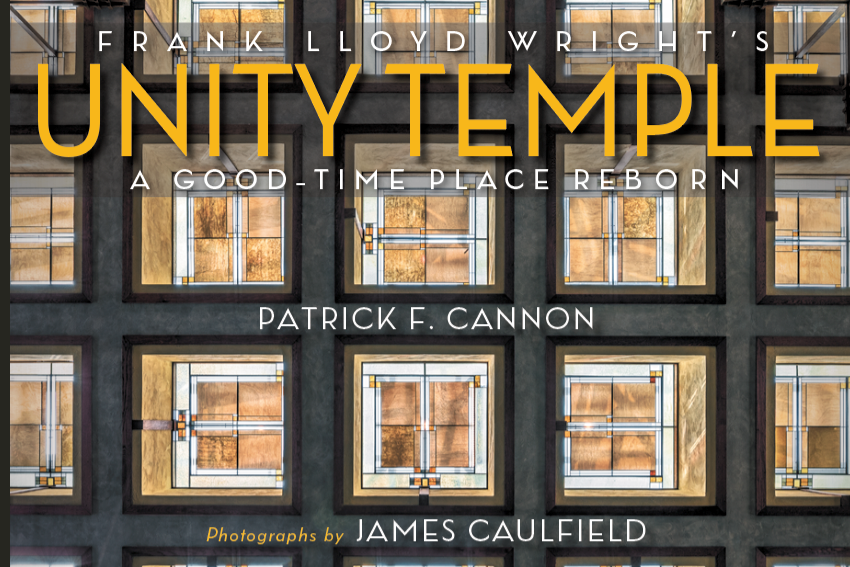![]()
 I previously wrote about contrasts and similarities between architect Antoni Gaudi’s most famous structure, La Sagrada Familia Basilica in Barcelona, and Unity Temple. Considering other travels to Europe and visits to churches and cathedrals of various architectural styles, I have been reflecting further on the techniques used by the designers of these buildings to draw your eyes upward to the heavens and create a sense of awe. Everyone who has visited Unity Temple and, after being compressed in the low ceilings of the Cloisters, climbs the narrow stairs to the elevated sanctuary and has their view drawn almost immediately upward to the light streaming through the leaded glass in the coffered ceiling. Wright was a master of “compression and release” to create dramatic transitions between spaces causing visitors to more fully appreciate the grand scale of the larger space. The clerestory windows around the top of room make the roof appear to float above the space.
I previously wrote about contrasts and similarities between architect Antoni Gaudi’s most famous structure, La Sagrada Familia Basilica in Barcelona, and Unity Temple. Considering other travels to Europe and visits to churches and cathedrals of various architectural styles, I have been reflecting further on the techniques used by the designers of these buildings to draw your eyes upward to the heavens and create a sense of awe. Everyone who has visited Unity Temple and, after being compressed in the low ceilings of the Cloisters, climbs the narrow stairs to the elevated sanctuary and has their view drawn almost immediately upward to the light streaming through the leaded glass in the coffered ceiling. Wright was a master of “compression and release” to create dramatic transitions between spaces causing visitors to more fully appreciate the grand scale of the larger space. The clerestory windows around the top of room make the roof appear to float above the space.

 The advent of Gothic architecture in the early 12th century resulted in the transition from Romanesque buildings constructed with thick walls, small windows and barrel vaults, to rib vaults with pointed arches that were taller and stronger. This allowed interior spaces to be larger and higher without the ponderous look of the more massive feel of Romanesque churches. Also, much larger windows could be placed between the ribs. The interiors of Gothic cathedrals are certainly awe inspiring. Abbot Suger of St. Denis Basilica in Paris, an early adopter of Gothic architecture, believed that light was a way to elevate the faithful from the material world to the divine. He enlarged a Romanesque Basilica and used Gothic techniques to add many large windows that filled the interior with light. Sound familiar? One of the things that makes Wright’s spaces so captivating is his ingenious use of natural and artificial light.
The advent of Gothic architecture in the early 12th century resulted in the transition from Romanesque buildings constructed with thick walls, small windows and barrel vaults, to rib vaults with pointed arches that were taller and stronger. This allowed interior spaces to be larger and higher without the ponderous look of the more massive feel of Romanesque churches. Also, much larger windows could be placed between the ribs. The interiors of Gothic cathedrals are certainly awe inspiring. Abbot Suger of St. Denis Basilica in Paris, an early adopter of Gothic architecture, believed that light was a way to elevate the faithful from the material world to the divine. He enlarged a Romanesque Basilica and used Gothic techniques to add many large windows that filled the interior with light. Sound familiar? One of the things that makes Wright’s spaces so captivating is his ingenious use of natural and artificial light.
![]()
 Renaissance architecture came into favor in the 15th and 16th centuries, initially in Italy. This style copied Greek and Roman designs by incorporating ornamental columns, rounded arches and domes. The source of celestial inspiration in Renaissance churches is typically the elaborate frescos on the ceilings depicting biblical scenes. The ultimate example of a Renaissance house of worship is Michelangelo’s St. Peter’s Basilica in Rome. In the 17th century, Baroque architecture took many aspects of Renaissance architecture and made them grander and more elaborately decorated. In addition to ceiling frescos, Baroque churches often employed trompe-l’œil techniques to create an even more dramatic effect of peering into the heavens. Wright takes the polar opposite approach by minimizing ornamentation and applying subtle color palettes to let the pure lines and masses of the architecture speak for themselves.
Renaissance architecture came into favor in the 15th and 16th centuries, initially in Italy. This style copied Greek and Roman designs by incorporating ornamental columns, rounded arches and domes. The source of celestial inspiration in Renaissance churches is typically the elaborate frescos on the ceilings depicting biblical scenes. The ultimate example of a Renaissance house of worship is Michelangelo’s St. Peter’s Basilica in Rome. In the 17th century, Baroque architecture took many aspects of Renaissance architecture and made them grander and more elaborately decorated. In addition to ceiling frescos, Baroque churches often employed trompe-l’œil techniques to create an even more dramatic effect of peering into the heavens. Wright takes the polar opposite approach by minimizing ornamentation and applying subtle color palettes to let the pure lines and masses of the architecture speak for themselves.
 Many things led to the decline in the construction of churches on a grand scale and few churches in America compare with the cathedrals of Europe. Congregations that had the means to build a large church typically chose scaled down Gothic style. We have the Oak Park Unitarian Congregation to thank for bucking that trend and selecting Wright to design a totally unique building that inspires a sense of awe in its own way.
Many things led to the decline in the construction of churches on a grand scale and few churches in America compare with the cathedrals of Europe. Congregations that had the means to build a large church typically chose scaled down Gothic style. We have the Oak Park Unitarian Congregation to thank for bucking that trend and selecting Wright to design a totally unique building that inspires a sense of awe in its own way.
 Many who are familiar with the houses Wright designed are not aware that, in addition to Unity Temple, he designed many structures for religious purposes. In each of them he employed different techniques to create a sacred space. The golden dome of Annunciation Greek Orthodox Church in Wauwatosa, Wisconsin is encircled by a ring of small round windows that, like Unity Temple, makes the dome appear to float over the sanctuary. In Elkins Park, Pennsylvania, the soaring translucent, peaked roof of Beth Sholom Synagogue inspired by Mt. Sanai, with the colorful, triangular pendant light hovering over the congregation, is dramatically celestial.
Many who are familiar with the houses Wright designed are not aware that, in addition to Unity Temple, he designed many structures for religious purposes. In each of them he employed different techniques to create a sacred space. The golden dome of Annunciation Greek Orthodox Church in Wauwatosa, Wisconsin is encircled by a ring of small round windows that, like Unity Temple, makes the dome appear to float over the sanctuary. In Elkins Park, Pennsylvania, the soaring translucent, peaked roof of Beth Sholom Synagogue inspired by Mt. Sanai, with the colorful, triangular pendant light hovering over the congregation, is dramatically celestial.  The tall skylight in the center of the ceiling of Annie Pfeiffer Chapel at Florida Southern College is certainly an example of Abbot Suger’s philosophy of using light to elevate the space from the material to the divine. In a more modest building, the high peaked roof and glass prow of the Unitarian Meeting House in Madison, Wisconsin, achieves an inspirational impact in an otherwise unornamented space. Wright took it outside at the Community Christian Church in Kansas City by projecting beams of light from the roof skyward to simulate a steeple.
The tall skylight in the center of the ceiling of Annie Pfeiffer Chapel at Florida Southern College is certainly an example of Abbot Suger’s philosophy of using light to elevate the space from the material to the divine. In a more modest building, the high peaked roof and glass prow of the Unitarian Meeting House in Madison, Wisconsin, achieves an inspirational impact in an otherwise unornamented space. Wright took it outside at the Community Christian Church in Kansas City by projecting beams of light from the roof skyward to simulate a steeple.
Architects across the centuries have worked in a variety of styles to create religious spaces that fill us with awe, whether or not you are religious. Frank Lloyd Wright proved that celestial inspiration can be achieved in unconventional ways, without the monumental scale of old-world Gothic, Renaissance or Baroque architecture.
By Ken Simpson


